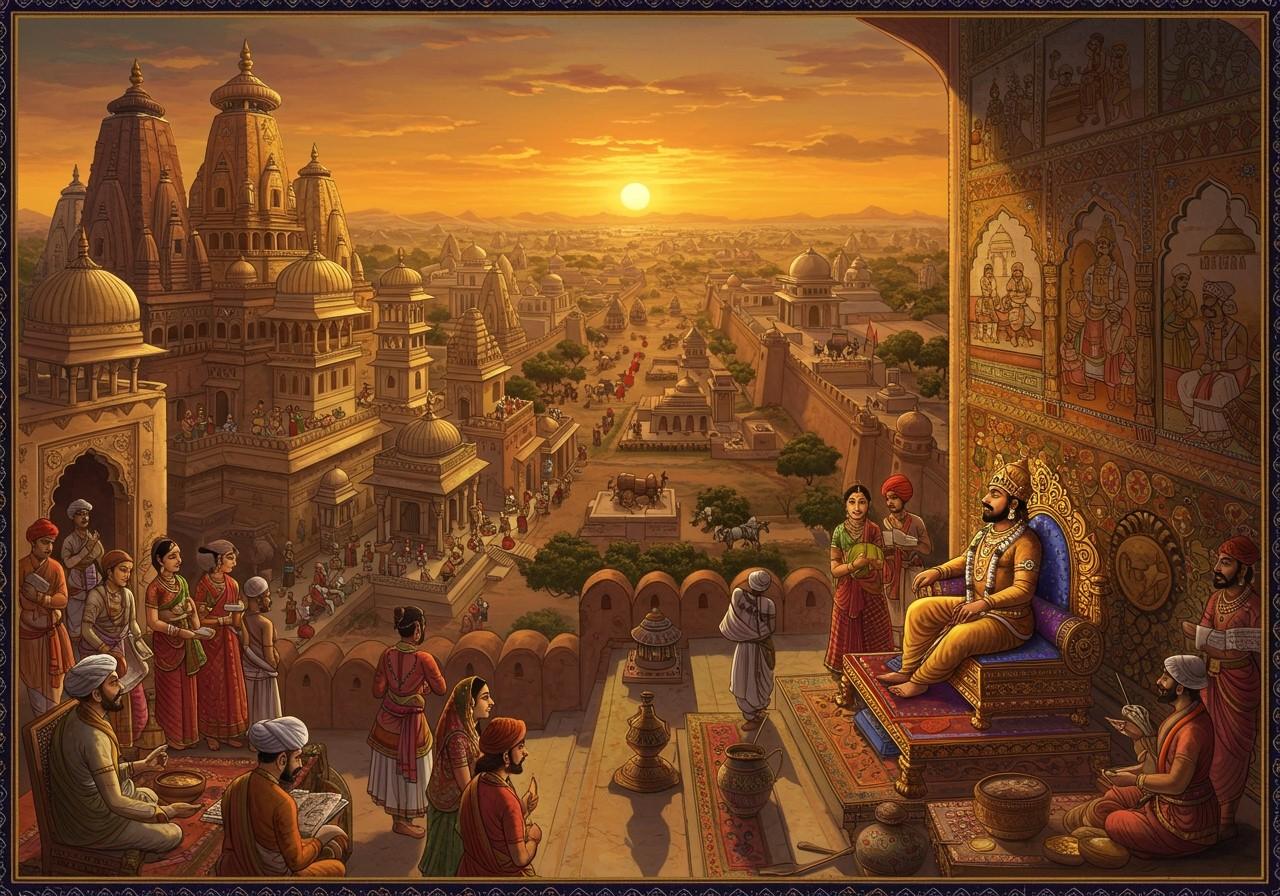
The Vardhana Dynasty, a pivotal era in Indian history, witnessed remarkable prosperity and cultural evolution. This article delves into the administration and capital of the Vardhana Dynasty, exploring its governance, the strategic significance of its capital, and the empire’s geographical reach. We will analyze the various aspects that characterized the dynasty’s reign, emphasizing key features and historical context.
Historical Background of the Vardhana Dynasty
The Vardhana Dynasty, also known as the Pushyabhuti Dynasty, reigned over northern India during the 6th and 7th centuries. Prabhakara Vardhana, the dynasty’s founder, consolidated smaller republics and monarchical states in North India following the decline of the Gupta dynasty. His son, Harsha Vardhana, became the last and most renowned ruler, significantly expanding the empire. This period marked a transition from fragmented political entities to a more unified northern India.
Key Aspects:
- Lineage: Prabhakara Vardhana established the dynasty, which culminated with the reign of Harsha Vardhana. Other notable rulers contributed to the dynasty’s expansion and consolidation of power.
- Socio-economic conditions: Trade flourished, agriculture sustained the populace, and population dynamics shifted during this period. These factors played a crucial role in shaping the dynasty’s policies and overall impact.
- Achievements: The Vardhana Dynasty made significant contributions to Indian culture and history, particularly during Harsha’s rule. These contributions encompassed various fields, including art, literature, and administration.
- Religious influences: Both Buddhism and Hinduism held sway during the Vardhana Dynasty, influencing the religious landscape and shaping philosophical thought.
Vardhana Dynasty’s Administration
Harsha Vardhana’s administration was despotic, with the king holding supreme authority. He actively participated in state affairs and frequently toured his kingdom to oversee governance directly. The king and his council of ministers played critical roles in decision-making and policy implementation, ensuring centralized control over the vast empire.
Key Aspects:
- Bureaucratic setup: A structured bureaucracy with designated officials and departments managed various aspects of governance. This system facilitated efficient administration and resource allocation.
- Tax collection: Land revenue and trade tariffs formed the primary sources of income for the state. These revenues funded public works, the military, and the administrative machinery.
- Judicial system: Royal courts dispensed justice and maintained law and order throughout the empire. The judicial system ensured fairness and upheld the rule of law.
- Military organization: A well-organized military defended the empire’s borders and maintained internal peace. Strategic alliances and military campaigns contributed to the dynasty’s expansion.
- Public works: The Vardhana Dynasty invested in infrastructure development, including irrigation projects, which boosted agricultural productivity and improved the lives of the people.
The Capital City of the Vardhana Dynasty
Initially, the capital was Sthaneshvara (modern-day Thanesar, Haryana). However, Harsha Vardhana later shifted the capital to Kanyakubja (modern Kannauj, Uttar Pradesh). Kannauj’s strategic location on major trade routes and its fertile surroundings contributed to its economic and political importance.
Key Aspects:
- Architecture: Kannauj boasted impressive architecture, including palaces, temples, and fortifications. These structures showcased the dynasty’s architectural prowess and cultural sophistication.
- Cultural activities: Kannauj thrived as a vibrant cultural hub, hosting bustling markets, grand festivals, and centers of scholarly pursuits. This fostered intellectual and artistic growth.
- Political center: As the capital, Kannauj housed the royal courts and government offices, serving as the nerve center of the empire’s administration. Important decisions regarding governance and policy were made here.
- Daily life: The city’s inhabitants experienced a dynamic social life, reflecting the diverse cultural influences and economic opportunities present in the capital.
Geographical Extent and Influence of the Vardhana Dynasty
The Vardhana Empire encompassed a vast territory, including substantial portions of northern and central India. Harsha Vardhana employed various methods of expansion and consolidation, including strategic alliances and military campaigns, to govern this expansive empire effectively.
Key Aspects:
- Territory: The empire’s boundaries extended across several regions, marking a significant expansion under Harsha’s rule. This vast territory presented administrative challenges.
- Expansion methods: Strategic alliances and military conquests were key to the empire’s growth. Harsha skillfully navigated the political landscape to expand his influence.
- Cultural influence: The Vardhana Dynasty significantly impacted the surrounding regions, disseminating cultural and artistic traditions. This cultural exchange enriched the intellectual landscape of the era.
- Trade: Trade played a crucial role in extending the dynasty’s influence, facilitating economic prosperity and cultural exchange with neighboring regions. Kannauj became a major trading center.
- Administrative challenges: Governing such a vast empire posed significant administrative challenges, requiring efficient bureaucratic systems and effective communication networks.
Legacy and Impact of the Vardhana Dynasty
The Vardhana Dynasty left a lasting impact on Indian history and culture. Harsha Vardhana’s reign saw advancements in art, literature, and religious thought, with influences from Buddhism and Hinduism shaping the period’s intellectual landscape. The dynasty’s contributions to administration, infrastructure development, and cultural exchange laid the foundation for future empires and contributed to India’s rich heritage.
Connecting with the Vardhana Dynasty through Poojn.in
For those intrigued by this era, Poojn.in offers a unique opportunity to connect with India’s rich past. We provide authentic ritual items reminiscent of the Vardhana period, including:
- Traditional brass diyas, similar to those used in ancient temples.
- Handcrafted puja thalis, for performing traditional rituals.
- Sacred thread (janeu), an essential element in Hindu ceremonies.
Explore our collection at Poojn.in and discover a tangible link to India’s historical and spiritual heritage.
Conclusion
The Vardhana Dynasty represents a significant chapter in Indian history, characterized by effective administration, cultural achievements, and strategic expansion. Harsha Vardhana’s reign ushered in stability and prosperity, demonstrating the dynasty’s commitment to governance and development. The capital’s relocation from Sthaneshvara to Kannauj underscored the dynasty’s adaptability to political and economic dynamics. The Vardhana Dynasty’s enduring legacy in art, literature, and religious discourse continues to inspire, showcasing a rich heritage that seamlessly blends tradition and progress. Studying this dynasty provides valuable insights into the foundation of India’s historical and cultural identity.


